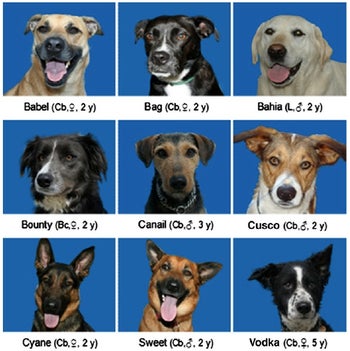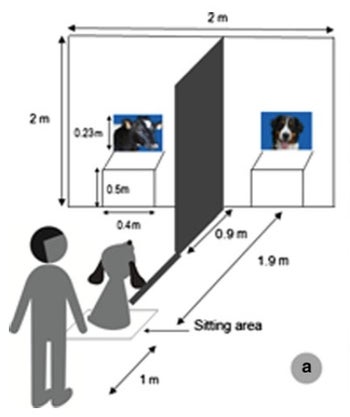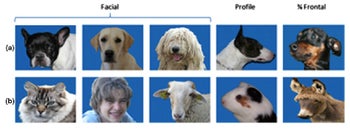Ever watched your pup interact with dogs of different ages and wondered if they somehow know the age difference? I’ve noticed my Border Collie acts totally different with puppies compared to senior dogs and it got me thinking – can dogs actually tell how old other dogs are?
The short answer is yes, dogs absolutely can determine each other’s ages! This fascinating ability isn’t just random or coincidental – it’s backed by science and relies on multiple sensory cues that dogs use to navigate their social world.
How Dogs Detect Age in Other Dogs
Dogs have evolved some pretty impressive ways to figure out if they’re dealing with a puppy, adult, or senior dog. Let’s break down the main methods they use:
1. The Power of Smell (Their Secret Superpower)
A dog’s nose is their most powerful tool for gathering information. With over 220 million scent receptors (compared to our measly 5 million) dogs can detect things we can’t even imagine.
When dogs meet they’re not just being nosy – they’re gathering critical information through
- Hormone detection: Puppies, adults, and seniors have different hormone levels that dogs can smell
- Pheromone analysis: These chemical signals reveal age, reproductive status, and more
- “Pee-mail”: Even without meeting face-to-face, dogs can determine another dog’s age just by smelling their urine marks
This is why you’ll often see puppies roll over and urinate slightly when meeting older dogs – they’re essentially “introducing” themselves with chemical information that reveals their age.
2. Visual Clues That Signal Age
Dogs don’t just rely on their noses. They also observe visual differences between dogs of different ages:
- Movement patterns: Puppies move clumsily as they figure out their bodies, adults move with confidence, and seniors often have stiffness
- Body proportions: Puppies have different proportions than adult dogs
- Size: While not always reliable (since breeds vary wildly), size can sometimes be a clue
It’s worth noting that dogs can tell age regardless of breed or size. A tiny adult Chihuahua knows that a large Labrador puppy is younger, even if the puppy is physically bigger!
3. Audio Cues: The Sound of Age
Dogs’ excellent hearing also helps them identify age:
- Bark pitch and quality: Puppy barks are higher-pitched and less developed
- Whines and growls: These vocalizations change tone and depth with age
- Breathing patterns: Even subtle breathing differences can signal age
One study showed that dogs can determine another dog’s size just by hearing their growl! This audio information helps them piece together age-related information.
4. Behavioral Patterns That Signal Age
The way dogs act is perhaps the most obvious giveaway of their age:
- Puppies: Boundless energy, poor boundary awareness, playful, easily submissive
- Adolescents: Testing limits, high energy but more physical control
- Adults: More measured energy, established social skills
- Seniors: Often more reserved, less playful, sometimes grumpy
When my dog meets a puppy, she immediately adjusts her play style – being gentler and more tolerant. With senior dogs, she’s remarkably respectful and submissive. These aren’t coincidences – she’s responding to the age cues she detects.
How Dogs Respond to Different Age Groups
How Adult Dogs Treat Puppies
Most well-socialized adult dogs recognize puppies and adjust their behavior accordingly:
- They show more patience and tolerance for puppy antics
- They offer gentle corrections when puppies cross boundaries
- They might teach social skills through play and interaction
- Some may avoid puppies entirely if they find their energy overwhelming
I’ve watched my friend’s older Lab interact with a new puppy, and it was amazing how he would gently correct the puppy when it got too rough, almost like saying “take it down a notch, kid.”
How Dogs Interact with Senior Dogs
Just as fascinating is how dogs typically respond to elderly canines:
- Many show increased respect and deference
- They often reduce play intensity to accommodate the senior dog
- They may protect or check in on elderly dogs in group settings
- Some will avoid bothering seniors who give “leave me alone” signals
This awareness of age helps maintain harmony in dog social groups and shows just how sophisticated canine communication really is.
Why This Matters for Dog Owners
Understanding that dogs can detect age differences has practical implications:
-
Better socialization planning: Introducing your puppy to well-socialized adult dogs can be valuable for teaching them proper doggy etiquette
-
Managing expectations: Not all adult dogs are patient with puppies, and not all seniors want to interact with younger dogs
-
Reading dog interactions: When you see your dog behaving differently with dogs of various ages, you’ll understand why
-
Respecting natural hierarchies: Dogs naturally form age-based social structures that help maintain order
Some Common Questions Dog Owners Ask
Can Dogs Tell If Another Dog Is a Puppy?
Absolutely! Adult dogs generally recognize puppies through:
- The distinct “puppy scent” they emit
- Their clumsy movements and proportions
- Their high-pitched vocalizations
- Their boundary-testing behaviors
This recognition usually leads well-socialized adult dogs to be more patient and gentle with puppies than they might be with other adult dogs.
Do Dogs Know When Other Dogs Are Old?
Yes, dogs can definitely identify senior dogs through:
- Changes in scent as dogs age
- Stiffness or slowness in movement
- Less playful behavior
- Sometimes increased vocalization
- Different body language and energy levels
Most dogs will adjust their interaction style with senior dogs, showing more respect and gentleness.
Personal Observations from a Dog Owner
As someone who’s raised multiple dogs, I’ve witnessed this age-detection ability firsthand. My three-year-old Border Collie behaves completely differently depending on the age of the dog she meets:
- With puppies: She’s gentle, patient, and moderately playful
- With dogs her age: She engages in rougher, more energetic play
- With senior dogs: She’s extremely respectful and submissive
It’s not that she’s been specifically trained to do this – she naturally adjusts her behavior based on the age cues she picks up from other dogs.
The Bottom Line on Doggy Age Detection
Dogs have evolved remarkable abilities to determine each other’s ages through smell, sight, sound, and behavior observation. This skill helps them navigate their social world and maintain appropriate relationships with dogs in different life stages.
Next time you watch dogs interacting, pay attention to how they adjust their behavior based on age – you’ll likely notice patterns that confirm this fascinating aspect of canine communication!
Tips for Supporting Healthy Multi-Age Dog Interactions
If you have dogs of different ages or frequently visit dog parks:
- Supervise interactions between very young and very old dogs
- Create safe spaces where senior dogs can retreat from energetic youngsters
- Redirect overexcited puppies if they’re bothering older dogs
- Respect natural boundaries that dogs establish based on age
- Appreciate the teaching moments that occur between different age groups
Dogs have been figuring out each other’s ages for thousands of years – it’s one of the many incredible social skills that make our canine companions so special!
Have you noticed your dog behaving differently with puppies or senior dogs? Share your experiences in the comments below!

On supporting science journalism
If youre enjoying this article, consider supporting our award-winning journalism by subscribing. By purchasing a subscription you are helping to ensure the future of impactful stories about the discoveries and ideas shaping our world today.
From a distance, my eyes play a cruel trick on me, where shopping bags are dogs and dogs are shopping bags until I get close enough and one wins out (obviously Im rooting for the dog).
But catch any part of a tail, and I know Im in. You could say my motto is, “dog, until proven otherwise.”
Does a dog know, merely by sight, that an approaching being is a fellow dog? Before you answer, remember this: Canis familiaris is the least uniform species on the planet. Members of this species come in a wide range of body shapes and sizes from itty bitty teeny weeny to absolutely ginormos. Adult members of this species appear as tight little packages, huge weightlifters, lean ballerinas, elongated hotdogs and everything in between.
Does a Pug look at an Afghan Hound and say to themselves, “Hello, dog!” or does a Pug look at an Afghan Hound and say, “WHAT IN THE WORLD ARE YOU?” and only after olfactory investigation (smelling) does the Pug realize, “Oh my goodness. How silly of me. Youre a dog. Sorry for the confusion my large, long-snouted compatriot.”
A number of researchers have essentially wondered what Pugs think of Afghan Hounds. Are dogs able to identify other dogs solely by appearance, they wondered? If olfactory cues are taken out of the equation, would a dog still know another dog when he sees one?
A team of researchers based in France took on this question, publishing their findings in Animal Cognition in 2013. Nine companion dogs joined as study subjects. They all had basic training and extensive experience with both dogs and people, and notably, the participants weren’t uniform in appearance — two were purebred (Border collie and Labrador), and the rest were mutts. Below are the study subjects in all their photographic glory (while they are all my favorites because they are dogs, I vote Cusco winner of Best Eyeliner and Best Ears, while Babel, Cyane and Sweet tie for Most Photogenic).

The experimental setup was simple enough: the nine subjects saw two screens, one on the right and one on the left with a divider between. In each trial, two s would appear simultaneously on both screens, and dogs were reinforced with a click and rewarded with a treat for approaching the “correct” screen — more on that in a moment. Heres what the experimental layout looked like:

To find out if dogs could ID other dogs based on appearance alone, the researchers first had to create a common language with their dog subjects. They did this with the help of three training sessions where dogs received a treat only when they approached the screen that had a picture of a dog’s face. Importantly, the same dog picture was used throughout the training sessions. During the training phase, the other screen was either all black, all blue, or had a picture of a cow’s face. The dog subjects were not rewarded if they approached any of the other non-dog pictures. This created a common language: “You are rewarded for approaching this ‘dog’ , nothing else.”
To proceed, the dogs had to approach the dog 10 out of 12 times in two consecutive sessions, which is better than approaching dog by chance. All nine dogs were able to do this. Common language secured!
.jpg?w=350)
Then came the test. Dogs were presented with a wide variety of never-before-seen dog faces paired against never-before-seen non-dog faces. As before, dogs had to approach the dog and avoid the non-dog to get a treat. This was no longer an easy feat as the dog s now captured dogs’ vast morphologic diversity in shape, color, size, head shape, ear position, you name it. On top of that, the dog s were now pared against a wide range of non-dog faces including human faces as well as domestic and wild mammals like cats, sheep, gerbils, cows, rabbits, reptiles, and birds, among others. s were presented head-on (full face) or as a profile. Below are examples of faces dogs saw in the study:

The dogs prevailed! The nine subjects successfully identified “dog” from “non-dog” faces. Some dogs, like Babel, Bag, Cyane and Vodka, were able to do so quite quickly, taking few sessions to approach the required 10-out-of-12 dog s. Other dogs, like Bahia and Cusco, were slower on the pickup and took more sessions to identify “dog” from “non-dog” (dog subjects needed anywhere from 2 to 13 sessions to meet criteria). This is not to say, of course, that Bahia and Cusco dont know a dog when they see one. The researchers highlight that a number of factors — like dog personality, learning styles and strategies, and motivation — can affect dog behavior and performance, particularly when it comes to this type of task.
Even so, the study suggests that despite their wackadoodle appearances, dogs can identify other dogs by sight alone. Dogs seem to have a sense of who (or at least which s) falls in the category of “dog” and who does not. Exactly which features dogs use when tuning into “dog,” though, the current study cant say. They offer that as a natural next step in the research.
Autier-Dérian D, Deputte BL, Chalvet-Monfray K, Coulon M, Mounier L. 2013. Visual discrimination of species in dogs (Canis familiaris). Animal Cognition, 16, 637—651.
